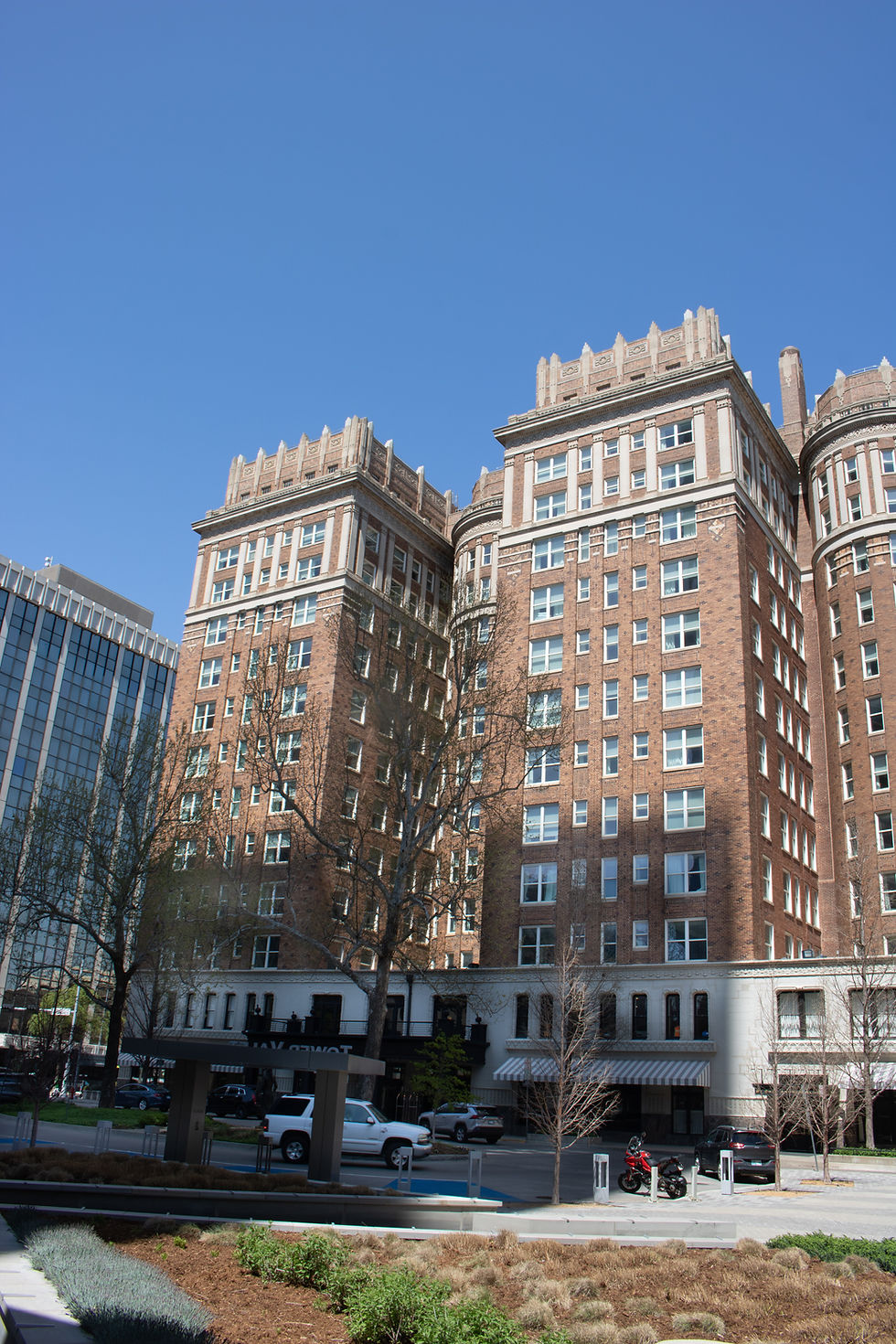top of page
The Alliance for Economic Development of Oklahoma City facilitates a wide range of projects to address diverse community needs. We collaborate closely with the Greater Oklahoma City Chamber, MAPS, and the City of OKC to coordinate land, incentives, and economic tools that enhance Oklahoma City's appeal to businesses and developers. The Alliance serves businesses of all sizes in a variety of capacities. Below are some of our signature projects from the past decade.

Signature Projects

Boeing High Bay
The Alliance helped facilitate the acquisition of a 30-acre parcel of land for the Boeing Company, directly west of the Tinker Air Force Base. With land rented from the Oklahoma Industries Authority, Boeing’s two large facilities significantly contribute to the continual growth of OKC’s $11.6 billion aerospace industry, drawing in skilled talent from across the region to work on the base. Operations at these sites focus on modernizing and modifying aircraft for the U.S. military, and include a high-bay hangar that currently houses a B-52 bomber that allows Boeing engineers to perform engine and avionics modifications in a controlled environment with accuracy.

OKC 577 Industrial Park
OKC 577 is a 577-acre master-planned industrial park in Oklahoma City. The site includes industrial, office, and retail components, with planned building sizes ranging from 20,000 SF to 2 million SF. Located one mile east of the I-35 and I-240 interchange, the site has direct frontage along I-240.
The park is fully served by utilities, including heavy power and large-capacity water and sewer infrastructure to support manufacturing. It is located within multiple state and federal incentive zones. OKC 577 incorporates flexible site planning, multiple access points, and integrated environmental and mobility features to support long-term operational needs.
%20(1).jpg)
Innovation District & Convergence
The Innovation District encompasses 1.3 square miles east of downtown OKC and contains a wide variety of organizations in OKC’s diverse sectors—healthcare, energy, aerospace, technology, research, academia and more. This district serves as a hub for research and technology. It will boost the region’s competitiveness in attracting talent and investment necessary for the continued growth of many high-income fields.
The first phase of planned development is projected to generate as much as $1.2 billion in annual additional economic impact, $423 million in annual payroll and 6,600 new jobs. This district is an important foundation for establishing OKC as an industry leader and regional hub for innovation and technology.
A highlight of the district is Convergence – a mixed-use development designed to foster an ecosystem of science and technology fields. Its pedestrian-friendly layout connects Oklahoma’s two largest universities and unites public and private sectors, creating an inclusive community that supports STEM growth. Its placement in the heart of the Innovation District offers an environment where professionals can live, work, and innovate together.

Omni Oklahoma City Hotel
Opened in early 2021, the stunning 605-room Omni Oklahoma City Hotel, serves as OKC’s Convention Center Hotel and represents one of the largest private investments in the city. The Omni brand is renowned for its distinctive designs, luxury accommodations, and dedication to exceptional customer service. With the increased capacity, Oklahoma City can now host larger conferences, attracting thousands of visitors each year and boosting the local economy through lodging, dining, entertainment, and shopping. In addition to generating its own revenue, the Omni has contributed to a rise in occupancy rates at other hotels in the area, thanks to the growth in conference-related business.

OKC Convention Center
Attached to the Omni Hotel is the MAPS 3 Oklahoma City Convention Center. This state-of-the-art building is a $288 million publicly-funded project and is capable of hosting large conventions, trade shows and events. At 500,000 square feet, the convention center includes a 200,730 square foot exhibit hall that can divide into four halls and 27 meeting rooms. The 29,874 square foot ballroom also includes pre-function space and a terrace overlooking Scissortail Park.
The center supports the full-service Omni Hotel next door, supporting OKC's bid for larger, regional and national conferences.

Scissortail Park
As one of the final MAPS 3 projects, Scissortail Park is the centerpiece connecting downtown to the Oklahoma River shore. It entices residents, visitors and downtown workers to enjoy a peaceful oasis in the heart of the city, while relaxing and grabbing a bite to eat from a nearby restaurant or food truck, enjoying a concert or event or taking part in a pickleball or basketball game on the newly built sports courts. This park was the catalyst for nearly $1 billion invested into private and public developments surrounding the park, including several food and entertainment options.
Scissortail Park is reshaping downtown OKC and represents how the MAPS programs and public investments have transformed our city and larger community.

First National Center
Built in 1931, the First National Center was once considered the star of Oklahoma City. The building was closed after years of deferred maintenance, and then restored, redeveloped and reopened in 2022. The First National Center underwent nearly $287 million in renovations through a mix of public and private investment, marking a major milestone as the largest commercial preservation project in Oklahoma’s history.
The center offers a 149-room hotel, 210 apartments, restaurants, and 35,000 square feet of retail, commercial, and event space. Residents enjoy amenities such as a concierge, rooftop pool and dog park, outdoor kitchens, and a theater. The Great Hall on the second floor was once the former bank lobby, and has been restored to its original Art Deco elegance and now serves as the hotel lobby and restaurant. It is a historically-preserved architectural gem. This development attracts people to downtown through employment, entertainment, luxury, and urban living.

Skirvin Hilton Hotel
The Skirvin Hilton Hotel reopened in 2007 after undergoing significant redevelopment and preservation efforts, funded by a mix of public and private sources. The $56.4 million funding plan approved by City Council in 2006 called for repayment of the public investment through loan proceeds, ground lease payments based on the success of the hotel, and a portion of the proceeds from the future sale of the hotel.

Pratt & Whitney
The Alliance for Economic Development of Oklahoma City played a key role in bringing international aerospace manufacturer Pratt & Whitney’s new $255 million OKC Sustainment Center to Tinker Air Force Base. The 845,000-square-foot facility expands Pratt & Whitney’s local operations, enhancing maintenance, repair, and overhaul (MRO) capabilities for the world’s most powerful fighter jet engine, the F135. This investment drives economic growth, creating high-skilled jobs and strengthening the city’s $11.6 billion aerospace industry.
With over 290 aerospace firms and 43,000 workers in the sector, Oklahoma City continues to build a global reputation in aviation and defense. The new sustainment center solidifies OKC as a hub for aerospace innovation and military readiness.

Neighborhood Infill and Revitalization
The Oklahoma City Urban Renewal Authority (OCURA) acquires undeveloped plots of land and/or crumbling, unused infrastructure within neighborhoods to coordinate with builders to create high quality, affordable homes.
A major component of OCURA’s mission is affordable housing and ridding the city of blight in order to enhance OKC residents’ quality of life. Neighborhood infill and revitalization helps support and grow traditionally under-invested regions of the city and ensures continuous production of affordable homes.

Page Woodson Development
This $10 million development, built in partnership with Colony Partners and the Oklahoma City Urban Renewal Authority, has nearly 500 residential units, 128 of which are affordable housing units. Located near the northeast corner of NE Sixth Street and N. Kelley Avenue,the developmentoffers a myriad of residential housing optionsand opportunities to the area, includeing.Built in 1910 as Oklahoma City's only all-Black high school, the historic Douglass High School—later renamed Page Woodson—was redeveloped into affordable housing and a community center after sitting vacant for 20 years following its 1993 closure.. In addition to the housing units, an African American Commemorative Plaza is planned to highlight the rich cultural history of the school and celebrating community contributions.

Homeland
Northeast Oklahoma City for years was considered a food desert due to the lack of available full-size grocery stores for residents. The Alliance worked as the developer, found funding partners and negotiated a lease with Homeland to open at 36th and Lincoln. This project had been underway for over twenty years as the City of OKC created a Tax Increment Finance (TIF) District for the site in 1998 and OG&E sold the land to The Alliance to help complete the site. The TIF financing helped bring a much-needed full-service and 30,000-square-foot grocery to NE OKC.
The main lender for this project, National Cooperative Bank, works with co-ops and specializes in the grocery industry. The Alliance partnered with Arkansas-based Heartland Renaissance Fund and U.S. Bank to get New Market Tax Credits, which are specifically designated for new construction in low-income areas.
Filter by Tags
bottom of page